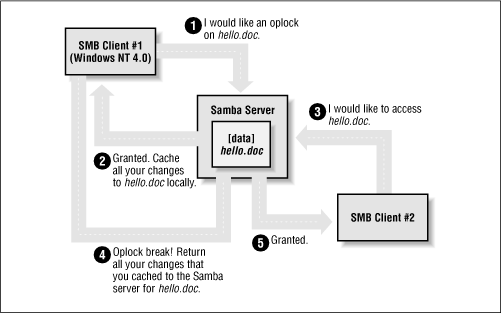Opportunistic locking allows a client to notify the Samba server that it will not only be the exclusive writer of a file, but will also cache its changes to that file on its own machine (and not on the Samba server) in order to speed up file access for that client. When Samba knows that a file has been opportunistically locked by a client, it marks its version as having an opportunistic lock and waits for the client to complete work on the file, at which point it expects the client to send the final changes back to the Samba server for synchronization.
If a second client requests access to that file before the first client has finished working on it, Samba can send an
oplock break request to the first client. This tells the client to stop caching its changes and return the current state of the file to the server so that the interrupting client can use it as it sees fit. An opportunistic lock, however, is not a replacement for a standard deny-mode lock. It is not unheard of for the interrupting process to be granted an oplock break only to discover that the original process also has a deny-mode lock on a file as well.
Figure 5.8 illustrates this opportunistic locking process.

In terms of locks, we highly recommend using the defaults provided by Samba: standard DOS/Windows deny-mode locks for compatibility and oplocks for the extra performance that local caching allows. If your operating system can take advantage of oplocks, it should provide significant performance improvements. Unless you have a specific reason for changing any of these options, it's best to leave them as they are.
